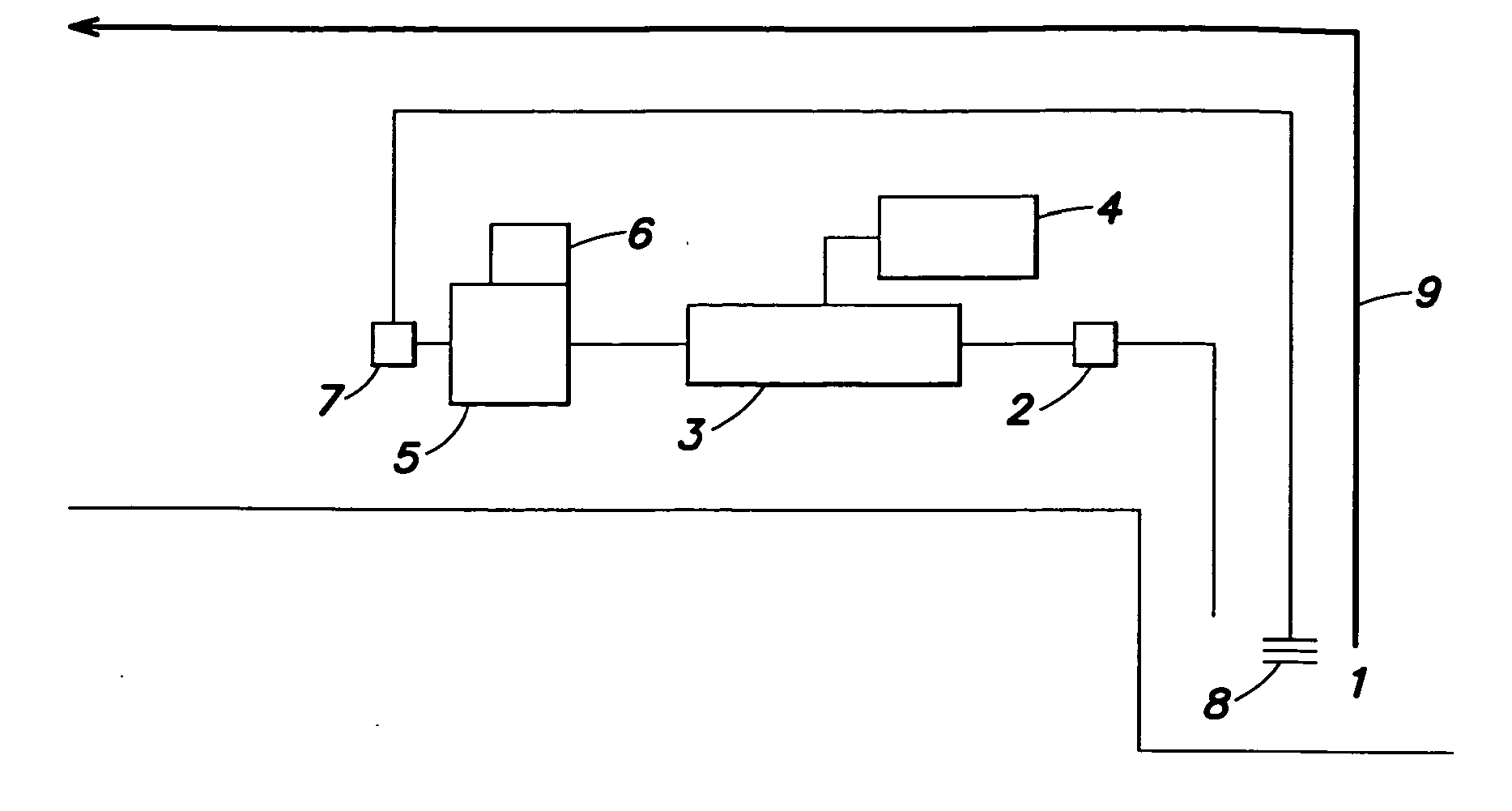Method and system for treating ballast water
a ballast water and treatment method technology, applied in the direction of vessel construction, separation process, nature of treatment water, etc., can solve the problems of system failure to consider the variabilities of chlorine demand in different ports, transfer can be detrimental to the environment,
- Summary
- Abstract
- Description
- Claims
- Application Information
AI Technical Summary
Benefits of technology
Problems solved by technology
Method used
Image
Examples
example 1
[0074]FIG. 7 presents a graph of ORP of cooling water discharged from an LNG carrier during the course of a 20 day observation period. The cooling water was treated with chlorine generated by a CHLOROPAC® electrolytic generator manufactured by Siemens Water Technologies Corp. The chlorine dose applied to the cooling water was set to be in a range of 0.6 mg / L. Every day at midnight the chlorine generation was interrupted for 2 hours to measure the ORP of the untreated water (ORP baseline).
[0075]During the observation period, the LNG carrier made several voyages lasting about five days each. The graph in FIG. 7 shows how the ORP values changed over time. The ORP values were observed to reach as high as about 725-750 mV when ship was at the open sea. The observed ORP was lower when the ship was either leaving or entering a harbor and was observed to drop to a level in a range of about 400-450 mV when the ship was at port. This difference in the ORP values, depending upon the location o...
example 2
[0079]FIG. 8 shows a chart depicting the relationship between ORP level and free chlorine concentration and pH of pool water. At a pH of about 7.5 units, an ORP potential of about 700 mV can be achieved with about 0.2 mg / L of free chlorine. The same potential at pH of 8.5 would require 3 ppm of free chlorine. FIG. 8 thus shows that without pH compensation, a treatment system based on free chlorine control would lead to unacceptable over-chlorination or under-chlorination conditions. Because fixed chlorine output-based treatments system are typically designed to meet the worst case scenario, i.e., at high pH, over-chlorination of ballast water can result, with associated increased corrosion potential and increased likelihood of DBP formation.
example 3
[0080]An aqueous solution of sodium chloride (20 g / L) and sodium bromide (60 mg / L) with and without 2 mg / L of urea was prepared using tap water to simulate typical coastal seawater, with low and high nitrogen compound concentrations in a manner similar to the techniques used to evaluate water treatment systems described in a draft Environmental Technology Verification protocol by US EPA and US Coast Guard.
[0081]One liter of the prepared solution was placed in an amber glass beaker and continuously agitated. Chlorine was added to the beaker at increasing dose levels while monitoring the ORP of the treated solution and the residual free chlorine concentration.
[0082]The graph presented in FIG. 9 represents the dynamics of the free chlorine residual and of the redox potential in the simulated ballast water for two tests with no and 2 mg / L urea added.
[0083]The data shows that when no urea was added to the simulated ballast water, an ORP potential of 700 mV was reached at chlorine dose le...
PUM
| Property | Measurement | Unit |
|---|---|---|
| oxidation reduction potential | aaaaa | aaaaa |
| oxidation reduction potential | aaaaa | aaaaa |
| water oxidation reduction potential | aaaaa | aaaaa |
Abstract
Description
Claims
Application Information
 Login to View More
Login to View More - R&D
- Intellectual Property
- Life Sciences
- Materials
- Tech Scout
- Unparalleled Data Quality
- Higher Quality Content
- 60% Fewer Hallucinations
Browse by: Latest US Patents, China's latest patents, Technical Efficacy Thesaurus, Application Domain, Technology Topic, Popular Technical Reports.
© 2025 PatSnap. All rights reserved.Legal|Privacy policy|Modern Slavery Act Transparency Statement|Sitemap|About US| Contact US: help@patsnap.com



